8 Types of Grass in North Carolina (with Pictures)
-
Pete Ortiz
- Last updated:
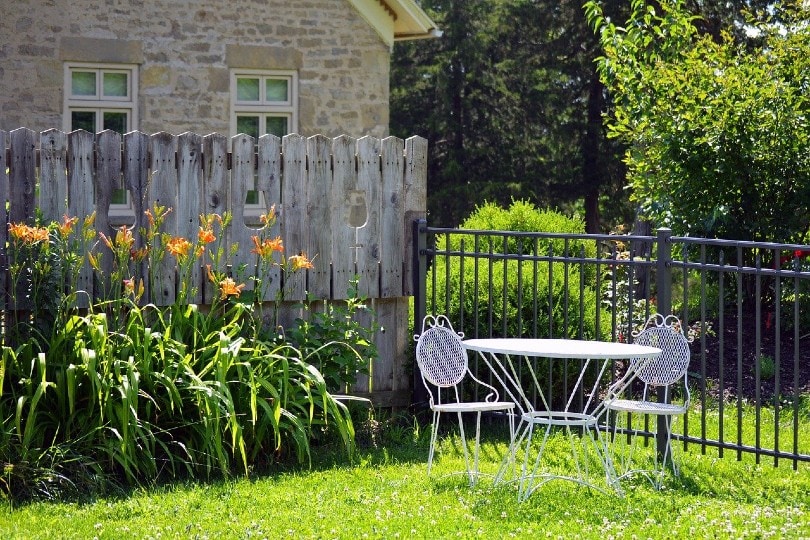
One of the main benefits of living in North Carolina is the diversity in landscapes and climates. In one place, you can enjoy snowy winter mountains and bright, breezy beaches that feel like summer all year long.
The only issue with the variety is that it can make picking your grass a little confusing. There is no one-size-fits-all grass for the “Tar Heel State”, so it takes a thoughtful approach to earn a thriving lawn. If you want to ensure the most vibrant growth for your backyard, we’ll break down the top choices for grass in North Carolina, including warm-season and cool-season types.
Growing Grass in North Carolina
Much of North Carolina sits in the tricky transition zone. Cold winters take out warm-season grass, and scorching summers damage cool-season varieties. USDA hardiness zones range from 5b on the northwestern end to 8b on the coast. For simplicity, you can consider North Carolina as having three essential planting zones:
- Northwestern mountain regions in zones 5–6
- Central Piedmont area in zones 6–7
- Coastal region in zones 7–8
The mountains and much of Piedmont exist in the transition zone. Meanwhile, the northeastern plains and southeast coast sit squarely in the warm-season region.
Living on the coast makes warm-season grass an obvious choice. But the soil conditions near the ocean can still limit the number of practical options. No matter where you live in North Carolina, your backyard’s soil, sunlight exposure, and use are as crucial as the climate in determining the best grass.
The 8 Top Choices for Your Lawn in North Carolina
Warm-Season Grasses
Warm-season grasses are ideal for the South, growing their fullest from July to September when temperatures reach 85°F–95°F. These varieties grow when the soil temperatures stay above 60°F–65°F. They’ll usually enter dormancy after the first fall frost, turning brown when the soil temperature dips below 50°F.
In parts of the Piedmont area and across the eastern side of North Carolina, warm-season grass is a must. It can handle the higher average temperatures of the lower regions and stay resilient in an extended drought and high-stress conditions. Choose different varieties for better cold-hardiness and shade or moisture tolerance to suit your unique needs.
1. Bermuda

| Sun requirements | Full |
| Water requirements | Moderate |
| Mowing height | 1–2” |
Bermuda grass is one of the best types of grass for North Carolina, a sturdy, warm-season variety that can handle heavy use and diverse conditions. After sowing seeds in the spring, you’ll see rapid growth as it spreads through rhizomes and stolons. Once established, you’ll enjoy a dense carpet of durable light-green grass.
Because it grows and spreads so fast, Bermuda grass is quick to recover from damage, making it perfect for high-traffic lawns where kids and pets play. Its fast growth also means you need to mow it more often. Otherwise, it makes for low-maintenance turf, only requiring about an inch of water per week.
- Where to Grow Bermudagrass: Bermuda grass is not the most shade-tolerant option, so use it in areas that receive at least 6–8 hours of daily sunshine. Choose Latitude 36, Yukon, or Riviera if you need a more cold-tolerant cultivar in the transition zone.
- Grass Pairing: Bermuda grass works well with several cold-season types of grass if you want to overseed for a year-round green lawn in the transition regions. Annual ryegrass is a good option that will die off fast and not compete for space. You can also mix Bermuda with perennial ryegrass, Kentucky bluegrass, and fescue with quality results. In a warm-season mix, Bermuda complements St. Augustine nicely.
2. Zoysia
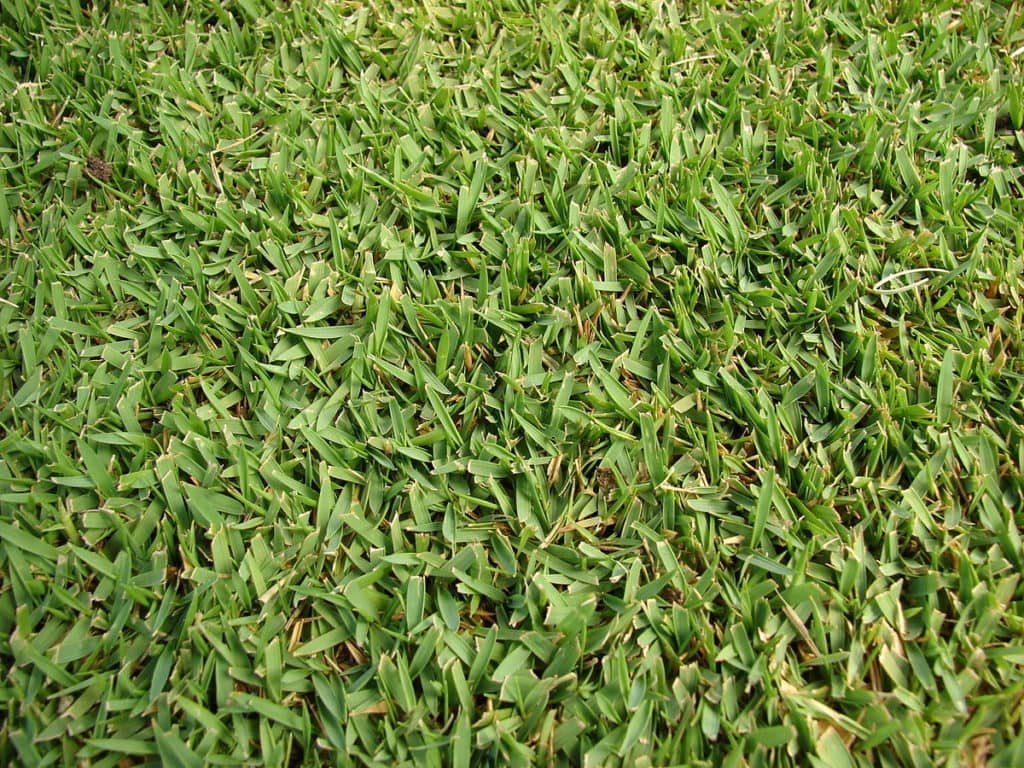
| Sun requirements | Full/partial |
| Water requirements | Moderate |
| Mowing height | 1–2” |
Zoysia grass is an excellent Bermuda grass alternative for North Carolina yards, and it boasts many of the same benefits. Growing via rhizomes and stolons and usable in various soil conditions, it’s another wear-resistant and resilient grass for creating lush, thick lawns all across the state.
Although it is much slower to establish (and more expensive) than Bermuda grass, the dense cushion of Zoysia grass is attractive and easygoing once it grows in. It generally requires less mowing than Bermuda, and it enjoys a higher resistance to pests and disease. Some varieties need dethatching, but otherwise, Zoysia is about as low-maintenance as grass can get.
- Where to Grow Zoysia: Zoysia is a preferred warm-season grass for North Carolina, particularly in the few areas where Bermuda won’t work. It handles colder climates better than Bermuda, and although it shines in full sun, it has an exceptional shade tolerance. If you have an area that only receives about 4 hours of sunlight, choose Zoysia.
- Grass Pairing: Zoysia tends to crowd out competing plants. That’s great when you want a weed-free lawn, but it also means that it can’t coexist with many warm-season types of grass. Instead, mix in cool-season grasses like Kentucky bluegrass or tall fescue if you want a longer-lasting green turf.
3. Centipede
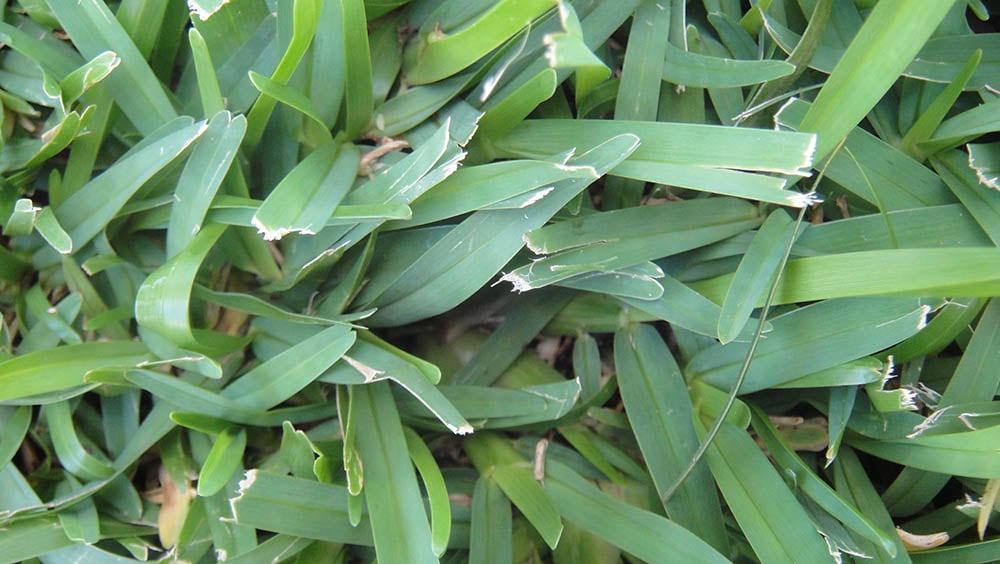
| Sun requirements | Full |
| Water requirements | Moderate |
| Mowing height | 1–2” |
With its pale apple-green color and coarse texture, the centipede isn’t the most visually appealing or enjoyable grass to walk on. Still, its aggressive growth and limited maintenance demands make it a practical option for many North Carolina lawns.
Like Zoysia, centipede grass can take a couple of years to establish and need occasional dethatching. Otherwise, there’s a good reason why it’s known as the “lazy man’s grass”. Centipede grows slowly, so it needs infrequent mowing, and there’s little demand for fertilizer.
- Where to Grow Centipede: Centipede grass is particular about its soil, but much of North Carolina provides ideal conditions. Grow centipede grass in sandy, acidic soil where it can get 6 hours of direct sunlight. In cold weather, centipede grass does not go dormant, so it is at risk of severe damage when frost hits. Avoid using it in the western regions of the state. Warm, humid areas in Piedmont and the coast provide an excellent climate for centipede grass to thrive. Centipede grass is not a wise choice for high-traffic lawns. If you have pets, children, or frequent backyard events, choose a stouter option like Bermuda or Zoysia.
- Grass Pairing: Although centipede is decent at crowding out weeds, it’s not so aggressive that it needs constant monitoring or extreme care in mixing it with other grasses. While Zoysia is a domineering grass, centipede will gladly share space with warm-season grasses like Bermuda and St. Augustine. Improve the look, feel, and tolerances of your lawn with a blend of warm-season varieties.
4. St. Augustine
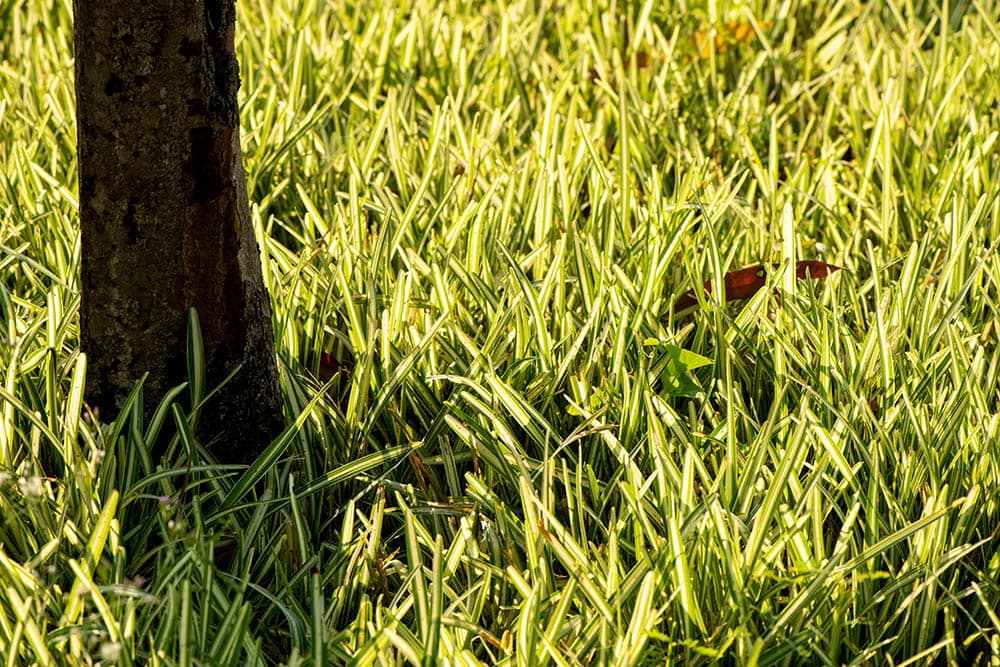
| Sun requirements | Full/partial |
| Water requirements | Moderate |
| Mowing height | 2–3” |
Another fast-growing spreading type, St. Augustine grass develops into a beautiful, thick lawn of coarse, medium to dark-green blades. Although it’s highly shade-tolerant, this grass does not stand up well to the cold, so it has the most limited use in North Carolina.
St. Augustine is efficient at taking over an area and controlling weeds, but it needs regular mowing. To get the best growth, you’ll need to apply fertilizer regularly and monitor for pests and diseases.
- Where to Grow St. Augustine: St. Augustine boasts unique advantages for specific spots in North Carolina, but it also has significant weaknesses that make it less versatile than other warm-season grasses. On the plus side, St. Augustine can handle heat, shade, drought, and salty soil better than most warm-season alternatives, making it a perfect fit for coastal regions in zones 8–10. Unfortunately, it’s also one of the least cold-hardy grasses, and it can’t survive long in waterlogged areas. It also doesn’t handle heavy foot traffic well. For North Carolina yards, choose one of the more cold-tolerant varieties like Delmar or Palmetto for the longest growing season.
- Grass Pairing: Due to its distaste for cooler temperatures, St. Augustine doesn’t work well in the transition zone or when overseeded with cool-season grasses. Instead, you can use it alongside Bermuda grass in warmer regions, especially if your lawn has varying areas of sunshine and shade. One type of grass may overtake the other depending on how you care for your yard, but they can work well in tandem to form a lush lawn.
Cool-Season Grasses
Cool-season grasses thrive in the spring and fall months while going dormant in hot summers and cold winters. In general, you want to plant them about a month and a half before fall frost hits, so they can grow in the fall and come back in the spring.
Growth starts when the temperature exceeds 40°F and kicks into full gear in temperatures between 65°F and 75°F. Although they withstand colder temperatures, cool-season grasses are less drought-tolerant than their warm-season counterparts.
5. Tall Fescue
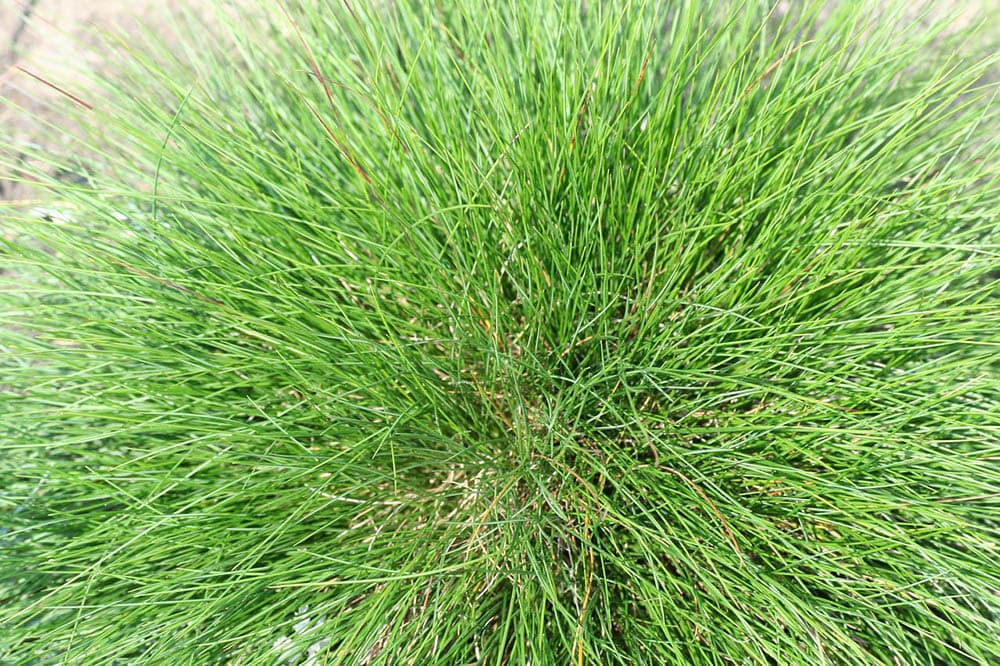
| Sun requirements | Partial |
| Water requirements | Moderate |
| Mowing height | 2–3” |
Tall fescue is a bunching grass, a variety that shoots short rhizomes and has a limited spread. As a result, it’s slower to heal than many other grass types and may need reseeding if it suffers severe damage. That one drawback aside, tall fescue offers numerous advantages over other cool-season grasses for North Carolina.
Although it spreads and repairs slowly, tall fescue is eager to germinate and fast to establish. A deep root system makes it more heat and drought-tolerant, perfect for a cool-season grass trying to get by in warmer climates.
- Where to Grow Tall Fescue: As a cool-season grass, tall fescue is more suitable for the mountain regions, but its heat tolerance can allow you to grow it well into Piedmont. It prefers well-drained soil and can stand both full sun and partial shade when you grow it in cooler areas of North Carolina. In the hotter, sandy soil around the coastal plains, tall fescue won’t hold up as well in full sunlight. Tall fescue grows via tillers instead of horizontal stolons and rhizomes, so it’s easy to manage its growth pattern. It isn’t challenging to grow alongside decorative plants and various ground covers because it can’t easily spread. Unfortunately, that makes it also slow to repair, making it less practical for high-traffic areas where rambunctious pets and children play.
- Grass Pairing: With its unique growth habits and care requirements, tall fescue hasn’t always performed well alongside other grasses. Over the years, new cultivars have come around that fit in nicely with select cool-season grasses. Mixing in Kentucky bluegrass is a practical way to increase the durability and resilience of your tall fescue lawn.
6. Kentucky Bluegrass
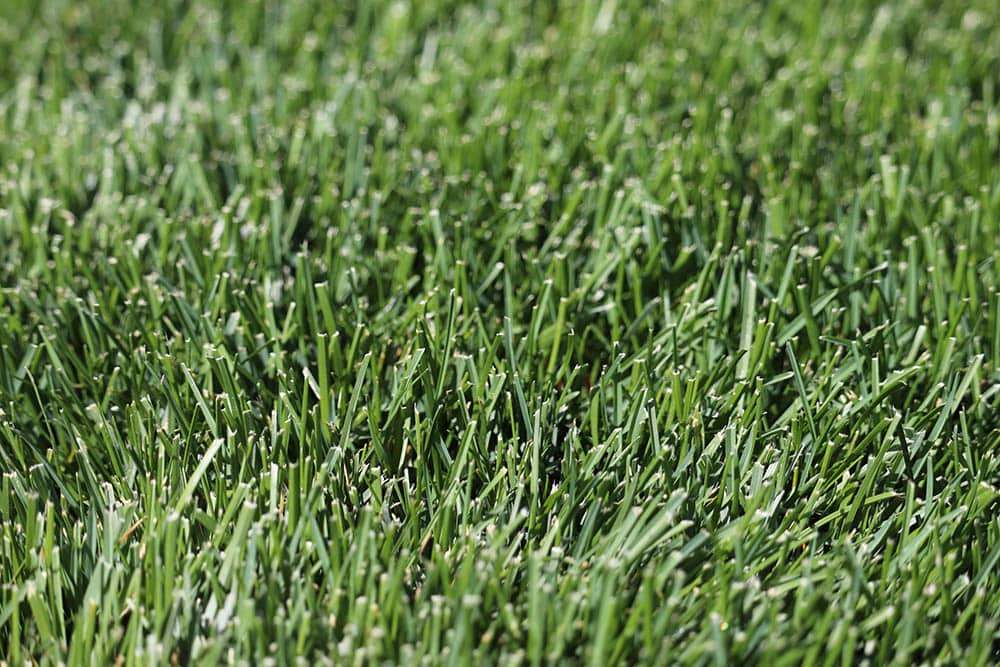
| Sun requirements | Full/partial |
| Water requirements | Moderate |
| Mowing height | 5–2.5” |
Kentucky bluegrass is prized for its gorgeous appearance, with well-established lawns developing into thick mats of medium-dark blue-green hues. The fine texture provides a desirable turf for backyards, athletic fields, and parks.
As it grows via rhizomes, Kentucky bluegrass has quality sod-forming properties and is quick to recover from damage. It thrives in full sun, but it will retain its rich color in partial shade. With its fast recovery, speedy growth after dormancy, and resistance to pests and disease, Kentucky bluegrass is one of the most reliable grasses available.
- Where to Grow Kentucky Bluegrass: Kentucky bluegrass is not as tolerant to drought or heat as tall fescue, so it’s best to grow it only in the mountainous regions of North Carolina. If you live in these cooler areas, this option is excellent for lawns that experience moderate traffic and varying levels of shade and sunlight.
- Grass Pairing: As mentioned, Kentucky bluegrass works well with tall fescue because the two balance each other’s weaknesses to make your lawn more adaptable. You can also consider adding perennial ryegrass for faster and sustained greening. If you decide to mix in perennial ryegrass, do so in moderation, as it can aggressively edge out the Kentucky bluegrass if given a chance.
7. Perennial Ryegrass
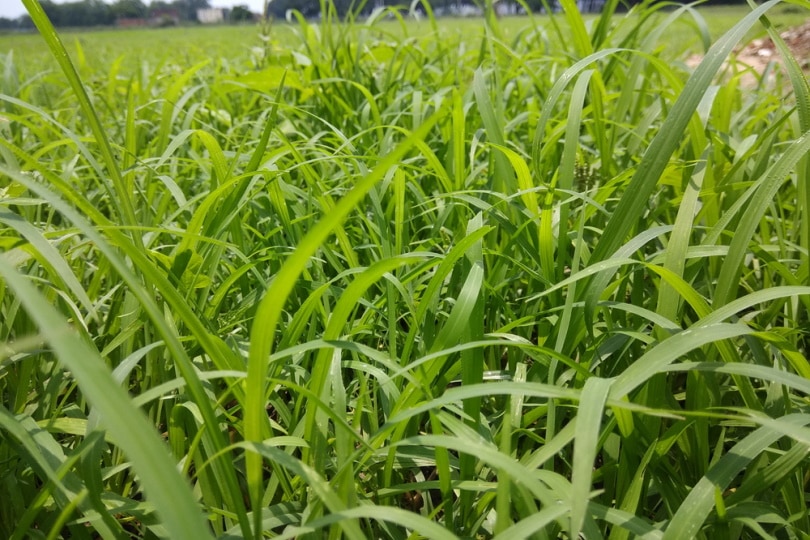
| Sun requirements | Full |
| Water requirements | Moderate/High |
| Mowing height | 5–2.5” |
Perennial ryegrass is a bunch-growing grass like tall fescue but exhibits much more aggressive growth. It germinates and establishes rapidly, only taking 5–7 days to sprout in many cases. It’s a durable cool-season grass, capable of handling decent amounts of wear and periods of higher heat.
The clumping growth and fast germination give perennial ryegrass unique advantages over many cool-season types of grasses. It can withstand heavy foot traffic better than tall fescue, and it crowds out weeds with ease. As it grows in bunches, it also won’t develop the thatch issues common to spreading grasses. And although its shallow root system makes its heat, shade, and drought tolerance lower than some other cool-season varieties, it boasts excellent pest and disease resistance.
- Where to Grow Perennial Ryegrass: Perennial ryegrass is not extremely heat-hardy. It’s best for the western third of North Carolina around the mountains. If your backyard gets at least 6 hours of direct sunlight and you live in a cool, humid area, this attractive and comfortable grass should be a strong contender for your lawn.
- Grass Pairing: Perennial ryegrass makes fine monostand grass in the mountains, but it is commonly blended with Kentucky bluegrass. The ryegrass grows faster to give you a green lawn immediately, while the Kentucky bluegrass boosts your lawn’s recuperation rate and fills in bare patches. You can also pair perennial ryegrass with Bermuda so that your cool and warm-season mix provides a green lawn from early spring through late fall. It’s crucial to limit the amount of perennial ryegrass when you use it with other varieties, keeping it around 20% of the total seed mix. If you sow too much ryegrass, it will likely crowd out and overtake many types of grass.
8. Fine Fescue
| Sun requirements | Partial |
| Water requirements | Moderate |
| Mowing height | 5–2.5” |
The dark green, needle-thin blades of fine fescue may make it seem delicate, but this bunching cool-season grass is one of the hardiest options for a mountain or Piedmont lawn. Poor soil conditions won’t hinder its growth, which also means it doesn’t need much fertilizer. It can also tolerate more shade and drought than tall fescue or Kentucky bluegrass.
- Where to Grow Fine Fescue: Soil quality won’t cause issues for fine fescue, but moisture retention can. It needs well-drained soil, and even high humidity areas can be problematic. Fine fescue also doesn’t hold up to extreme heat or heavy foot traffic. Get the most out of it by using it in dry, shady areas.
- Grass Pairing: Since fine fescue has a tough time spreading, it pairs well with Kentucky bluegrass, which can help fill in the gaps. It’s a versatile blend that provides better wear resistance, repairability, and sun tolerance than fine fescue will offer by itself. You can also blend it with tall fescue to give you a lawn that can grow higher.
Conclusion
North Carolina’s transition and coastal plains can seem challenging, but there is a silver lining to its unique conditions. It gives residents many grass options that wouldn’t work anywhere else in the country. With some careful planning, you can create a flourishing blend that can last through most of the year.
Featured Image Credit: 1000 Words, Shutterstock
Contents


